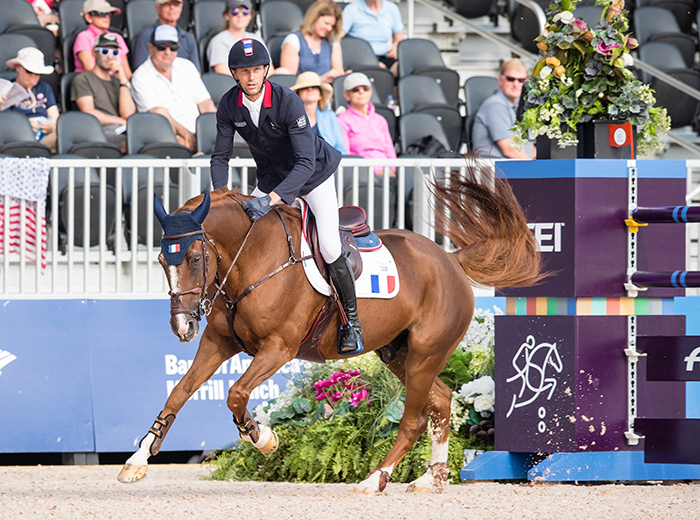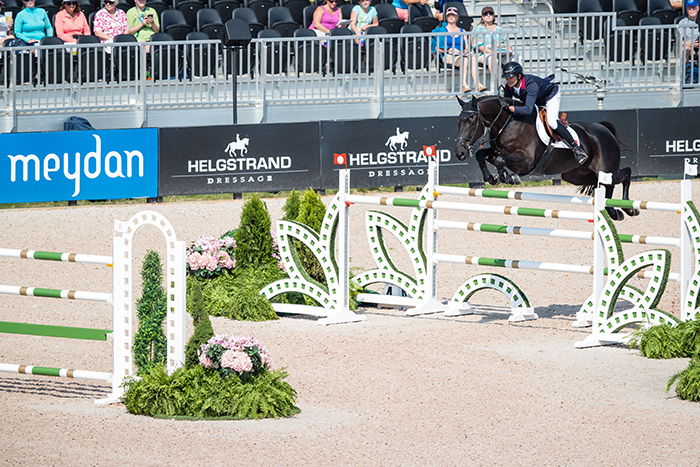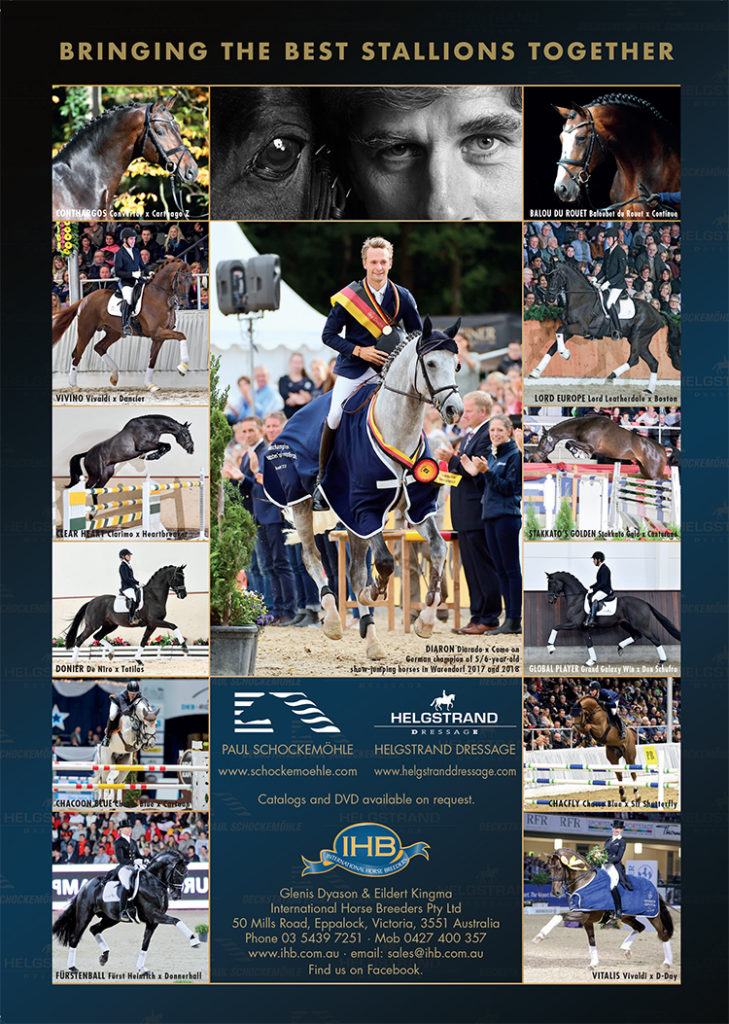Missed part one? It’s here. Part two is here Part three is here Part four is here
Our guest jumping trainer, George Sanna looks at what happens when you put two fences together…

Combinations – twice the problem?
“More than twice the problem, because two jumps are already twice the problem of one, but with combinations, you have a compounding effect. With a single fence if you approach and jump it poorly, it is not such an issue because you have time to re-group and get organized for the next jump, but with a combination, you will often jump in, and jump in clear, and leave yourself unable to jump out. Not only do you have to jump the fence in cleanly and well, but you have to jump it in a way that enables the horse to jump the next jump comfortably.”
“Again there is more pressure on the horse and rider to get a good distance coming in. If you get too deep, your horse will shorten up, go up in the air, land short, land flat footed, take a stride and be too far away from the next jump – or jump in a little long and flat, maybe leave the jump up, but he takes a stride and he is too close to the next element and either takes it out at the roots or feels he can’t jump it and pulls up.”

“It’s more than twice the problem in many ways, but the flip side is, if you jump in well, you don’t have the issue of having a bad distance coming out because the distance is set up for you. If you jump in well, then you’ve actually jumped in for two jumps – you’ve got two distances. When you talk about combinations and related lines, there is not an issue of finding a distance, we have a plan. You walk the combination – or line – and you have a plan. It might be to jump in normal, it might be to jump in forward because the distance is long, or it might be to jump in collected because the distance is very short.”
Story continues below the advertisement

“You try to ride to that plan as best you can. There is not an issue of seeing a distance in a combination, you ride to a plan, and if you execute the plan well, it’s done. If it is a little long, you jump in forward, the horse lands he’s got momentum he takes a stride and jumps out. Jump in collected to a short one, pop in, he’ll balance himself, and he’ll jump out. If it is a little long and you jump in short, it is salvageable, provided you land and you kick. Similarly, if it’s short and you jump in a bit big, you may well get the fence jumped if you sit up early and you say ‘whoa’ and tell the horse clearly that it is short, then once again the horse can jump the fence quite well, if it is not extremely long and flat or extremely short and backwards.”

“Normally with amateurs we assume inconsistent distances and the odd distance error, normally amateurs will come undone in combinations. When things start to unravel, it will be at a combination normally – jumping in with crappy distance – with a single jump and an honest horse, he would manage the first fence but then he can’t jump out, he gets scared and that is normally the beginning of a downwards spiral.”
How do we work on this at home?
“Just following up on the amateur thing, you’ve got to set your standard to the lowest common denominator – you’ve got to assume you are going to give your horse the average worst ride – not the most shocking one – but an average bad distance, but the jump is still at a height where the horse is going to be able to get out the other side of the combination. It’s not going to be a metre forty, it’s going to be 90 cm – depending on what level of amateur we are talking about – so the question is, with rider’s average ride or slightly less than average ride, will the horse be able to get out of the combination? If you are thinking ‘they are going to have to nail this, otherwise the horse is not going to jump out of the combination’ – then they shouldn’t be pointing at it. You’ve got to assume they are not going to nail it, they are at best going to be not too bad.”
Story continues below the advertisement

“For the novice riders the combinations need to be set easier. Often you are teaching kids with shorter striding ponies and you’ve got to understand how difficult it is for little horses to jump normal distances. If you can imagine you are riding your normal striding horse and you open up all the distances in the combinations by two or three feet – how difficult would that make it? If you don’t catch that forward and positive and going, then your horse can’t jump it – well that is the pressure a small horse is under with normal distances.”
“I think as course builders, building junior classes in particular, with a mixture of horses and ponies, it is very very difficult. Generally it’s smart to make your combinations with two strides and normally with a vertical out, so that the ponies can chip if they have to and not end up draped over the back rail.”
The combination becomes more complicated when it starts to vary oxer to vertical or vice versa?

“Yes and no. Vertical to vertical increases all the aspects about the vertical. The questions of balance and the pace required to jump a vertical are all accentuated in a double of verticals. If you go in flat and long you might get away with it going in, but you won’t get away with it coming out – the balance and the collection of the canter, the distance, all those things we talked about with the verticals are increased with a double of verticals.”
“On the other extreme, a double of oxers, then all the things we talked about – being forward, in front of the leg, strong off the ground – they are even more the case for a double of oxers. Vertical / oxer, ideally you need to have a vertical balance with a oxer canter pace, vertical distance, vertical connection, but with a little more than you would normally jump that vertical if it was just on its own. Oxer / vertical, you’ve really got to jump your oxer, you’ve really got to think, I’ve got to jump my oxer and then I have to be very good with my upper body, to encourage the horse to rock back, and sit up and give him a little bit of room to that vertical. I need to be good with my release over the back of the oxer, so my horse is not already shortening his body over the oxer, I’m encouraging him to jump the back of the oxer, but when he lands, get my shoulders back, whoa, close my fingers on his mouth a little, really compress his stride, to give him room to the next jump, so he doesn’t sprawl over the vertical.”
The treble is just adding another element?
“The principles are exactly the same but the problem has a capacity to compound, just like the problem compounds from a single fence to a double, then the treble has the capacity to compound further.”
“Let’s say the course builder wants to set up a scope test – and he has a decent sized oxer coming out of a treble. A lot of riders make the mistake of thinking, okay this is strong coming out, I need to get into this combination really positive and really forward, and give my horse the opportunity to jump out – but in fact, that attitude nearly always has the opposite effect, and that is that you end up jumping strong over the fence coming in, whatever it is, so you get deep to the fence in the middle, it backs them up and they lose a lot of their momentum, so they have to suck back off that second fence, they climb up and land short, and that actually makes it longer to the last element.”
Story continues below the advertisement

“In that situation the ideal ride is to come in a little bit under-done, you don’t jump in too big and then you press forward over the middle element, so the last element comes at you. Conversely, if the test coming out of the combination is short and tall, then it is the opposite. Try and jump in a little forward, try to back up over the middle element, so they land steeper and you can get them back earlier. You’ve got to understand the dynamics and the physics of how horses jump – how things work.”
“You can get away with a bad ride to one jump, over a double you are less likely to get away with it, and over a treble, you are even less likely to get away with it.”
The Expert’s Eye
Photo 1:
Looking at that photo, where the jump is not even in view, he has certainly got a canter that is very up and collected and connected. He’s sitting pretty upright, the horse’s front end is up, he’s got his hocks well underneath him and he looks like he is approaching a combination – as opposed to say, a triple bar or a water jump. He is really together, which is always the best way to get into a combination – not to fall in going long, but to come in, connected.
Photo 2:
This doesn’t add a whole lot, he is certainly getting there, he certainly has no appearance of running at it. By the look of the canter and even on the take off, he is not running the horse forward. He is not too worried about the back rail by the look of it. He’s got the horse nice and active and forward and strong.
Photo 3:
Over the jump itself he’s got what I’d call a medium release, sort of an automatic release – not a big release. Once again, not looking like he is at all worried about the back rail, he’s not over-riding the horse, but he is probably a little more forward than he would be over a vertical for arguments sake.
Photo 4:
He is fairly right there, but once again he’s got a shortish release at this point, and I see as the jump goes on that he is getting a little behind the horse and making sure it doesn’t over-jump this vertical. For the landing side he is actually sitting up – he looks like he is figuring that the distance to the third part of the combination is quite short – he is sitting up against the horse quite noticeably.
Photo 5:
He is jumping that oxer out very comfortably by the look of it. He has given the horse a little more release – as you do coming out. When there is another element to come you have to balance the horse more, here his release is softer, and the horse has got his head lower. Judging by the way he has ridden it, he has come in with a pretty collected canter, he hasn’t jumped in too strong over the first element, he hasn’t chased him to it. He’s had just a normal distance to the middle, and he is worried about the distance to the last being quite short, so he is sitting against the horse. Then he is comfortable with that distance and he has given the horse a good release coming out.





